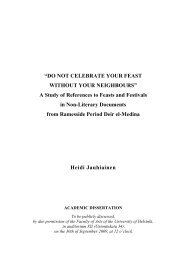BIA
bia51
bia51
Create successful ePaper yourself
Turn your PDF publications into a flip-book with our unique Google optimized e-Paper software.
JUIN 2015<br />
After more than a decade of restoration<br />
both monuments have now been reopened to<br />
visitors. Minister of Antiquities Mamdûh al-<br />
Damâtî, Cairo Governor Galâl al-Sa‘îd and Aga<br />
Khan Trust for Culture (AKTC) General Manager<br />
Luis MONREAL were all on hand to cut the<br />
ribbon on Wednesday night as part of the<br />
monuments’ official reopening. Prime Minister<br />
Ibrâhîm Mihlib was scheduled to attend the<br />
event but cancelled at the last minute.<br />
al-Damâtî told attendees that the restoration<br />
projects for both monuments highlighted the<br />
strong and fruitful cooperation between the<br />
ministry and the AKTC. He said the restoration<br />
of the wall sections had cost $8.5 million while<br />
restoration of the dome had cost $6.8 million.<br />
Both projects are part of a much larger<br />
urban regeneration programme undertaken by<br />
the AKTC with the support of the Egyptian<br />
government, the governorate of Cairo, the<br />
Ministry of Antiquities and other partners.<br />
It includes the 30-hectare (74-acre) al-Azhar<br />
Park, a number of restored mosques, schools<br />
and public spaces, training programmes for the<br />
youth of the area, health and education<br />
initiatives and improvements to water and<br />
sanitation.<br />
Deputy Minister of Antiquities for Islamic and<br />
Coptic Monuments Muhammad ‘Abd al-‘Azîz told<br />
the Weekly that restoration work carried out on<br />
the Ayyubid walls included consolidation of the<br />
gates and towers and the replacement of<br />
damaged and missing stone blocks with new<br />
ones. Cleaning work also took place, and salt<br />
that had accumulated on the walls was<br />
removed and a new lighting system installed.<br />
Salâh al-Dîn al-Ayyûbî started the<br />
construction of the walls in 1176 CE. He<br />
wanted to contain the former Fatimid palace<br />
city and its suburbs, the pre-Fatimid city of<br />
Fustât, and the pre-existing fortifications within<br />
a single system. In the centuries that followed,<br />
Cairo’s rapid expansion went well beyond Salâh<br />
al-Dîn’s boundaries, rendering the old walls<br />
obsolete.<br />
In the 15 th century, the eastern part of the<br />
city went into decline, and the Darrâsa area,<br />
where al-Azhar Park is now located, became a<br />
rubbish dump. In the 20 th century, the Ayyubid<br />
walls were largely covered in rubble and lost<br />
several parts of their historic structure.<br />
During excavation and grading works for al-<br />
Azhar Park, a 1.5-km section of the remaining<br />
Ayyubid walls stretching from Bâb al-Wazîr to<br />
al-Azhar Street was restored to international<br />
standards. It now forms the boundary between<br />
the Darb al-Ahmar district and the Park.<br />
‘Abd al-‘Azîz said that Cairo’s Ayyubid walls<br />
were built in Bâb al-Wazîr in the al-Darb al-<br />
Ahmar area by architect Bahâ’ al-Dîn Qarâqush<br />
on the orders of Salâh al-Dîn al-Ayyûbî to<br />
protect Cairo from invasion.<br />
Qarâqush built circular walls around Cairo,<br />
along with the al-Gabal and al-Fustât fortresses.<br />
He constructed several gates in the walls,<br />
among them Bâb al-Bahr, Bâb al-Sha‘riyya and<br />
Bâb al-Mahrûq. Restoration work on the gates<br />
started in 1999.<br />
Just outside the Ayyubid walls on the<br />
southern side of al-Azhar Park stands the<br />
Tarâbây al-Sharîfî Dome, which includes a<br />
mausoleum, gate, sabîl-kuttâb (water fountain)<br />
and madrasa (school). The building is a<br />
beautiful proportioned and exquisitely decorated<br />
structure with a zigzag pattern carved on its<br />
stone dome. It was built in 1505 for Tarâbây<br />
al-Sharîfî, commander of the Mamelukes under<br />
Sultan Qunsuwwa al-Ghûrî. According to ‘Abd<br />
al-‘Azîz, Tarâbây al-Sharîfî was a slave<br />
purchased by the Mameluke Sultan Qâytbây,<br />
who was subsequently freed and appointed<br />
amir, or prince, in the late 15 th century.<br />
Another Mameluke, Azdmar, was also<br />
purchased by Qâytbây and appointed to a<br />
number of governmental positions. He built his<br />
tomb on the northern side of the mausoleum<br />
of Tarâbây, but there is no documentation<br />
regarding the relationship between Tarâbây and<br />
Azdmar to explain why their mausoleums were<br />
constructed in such close proximity.<br />
<strong>BIA</strong> LI — Janvier/Juin 2015 160



